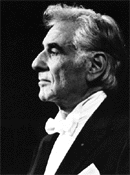Leonard Bernstein: What Does Music Mean?
Saturday, January 18, 2020 by Mary O'Connor | composers

On January 18, 1958 Leonard Bernstein began presenting his television series What does music mean? The series ran for 53 programs. Some of the episodes can be found below:
Part 1 What is Classical Music?
Plot: Bernstein conducts Handel's Water Music and cites it as an indisputable example of classical music. "Exact" is the word that best defines classical music, Bernstein says and he demonstrates with musical illustrations from Bach's Fourth Brandenburg Concerto, Mozart's Concerto No. 21 in C Major and The Marriage of Figaro, and Haydn's Symphony No. 102.
The decline of classical music at the end of the eighteenth century is tied to Beethoven's innovations and the Romantic movement, and Bernstein conducts Beethoven's Egmont Overture.
Part 2 What is Melody?
Plot: Bernstein discusses the different forms melody can take, including tune, theme, motive, melodic line and musical phrase. He illustrates by conducting the orchestra in excerpts from Tchaikovsky, Wagner, Hindemith, and Brahms.
Part 3 What is a Mode?
Plot: Bernstein discusses scales, intervals, and tones, and analyzes several pieces, including Debussy's Fêtes, Rimsky-Korsakov's Scheherazade, and music from the Kinks and the Beatles, to illustrate different modes.
An excerpt from Bernstein's ballet Fancy Free is also performed.
Music Lessons Spur Emotional and Behavioral Growth in Children
Friday, January 10, 2020 by Mary O'Connor | lessons
From the Washington Post, but we knew this already, right?
Music training not only helps children develop fine motor skills, but aids emotional and behavioral maturation as well, according to a new study, one of the largest to investigate the effects of playing an instrument on brain development.
Using a database produced by the National Institutes of Health Magnetic Resonance (MRI) Study of Normal Brain Development, researchers at the University of Vermont College of Medicine analyzed the brain scans of 232 healthy children ages six to 18 specifically looking at brain development in children who play a musical instrument. (The original study did not indicate specific instruments.)
"What we found was the more a child trained on an instrument," said James Hudziak, a professor of psychiatry at the University of Vermont and director of the Vermont Center for Children, Youth and Families, "it accelerated cortical organization in attention skill, anxiety management and emotional control."
Read the entire article at Music lessons spur emotional and behavioral growth in children, new study says - The Washington Post.
No School - Snow Day!
Wednesday, January 8, 2020 by Mary O'Connor | holiday
Fairfax County has closed school today so...no lessons today due to the snowy weather.
Keep practicing!
Those using Piano Maestro may find a new assignment for today :)




